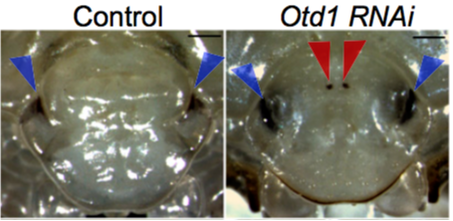Mission Cerveau Nord - BrainReach North
|
Scientists at Indiana University have succeeded in making a third eye grow on the forehead of a beetle, and it wasn’t just for their entertainment! In fact, scientists have been trying to study evolution by growing extra eyes on fruit flies for many years, but in places they don’t usually belong, like on wings or legs. The development of a functional third eye on a beetle’s forehead is the first recorded success. How exactly does a monster-looking insect help us learn about evolution? The development of an animal’s organs or body parts is directed by specific genes. By using genetic tools to alter an animal’s genetic makeup, scientists can learn how normal development of a beetle’s head occurs. In other words, scientists can find out how a small genetic change affects the course of an animal’s development. In this way, scientists are one step closer to understanding how new traits arise across generations. You may remember that Darwin developed his theory of natural selection after he observed variation in the traits among animals within the same species, and that some of these traits persisted over others in later generations. Currently, scientists are trying to figure out how this happens. The researchers at Indiana University learned that the evolution of a complex trait, like a third eye, might not actually be so complex! Researchers can inactivate specific genes so that they no longer do their original jobs. Here, the researchers inactivated the gene orthodenticle, which is normally involved in signalling how a beetle head should develop. When orthodenticle was inactivated, the researchers observed that, instead of a developmental chaos, other genes combined in a new way, giving rise to a third eye. Growing a third eye did not involve an entirely new gene; rather, it was the result of a new combination of pre-existing genes. While the mechanism for how new traits spontaneously appear in nature is still unclear, this evidence suggests that new traits, like a third eye, may not develop completely out of the blue but from our existing genetic blueprint! Figure from the original article. On the left is a typically developing beetle, while on the right is the beetle with a third functional eye (indicated by red arrows) created by inactivation of the gene orthodenticle. These findings are also exciting in light of what can be done to reverse the negative impact of blindness. The researchers first had to check whether the new eye worked. To do this, they put blind two-eyed beetles and blind beetles with the additional eye in a light test and compared how they behaved. The blind beetles with the third eye behaved as if they detected light. Since the two regular eyes were blind, the beetles most likely were able to see with their third eye! This observation tells us that growing a third eye can partially rescue blindness.
It may have taken three eyes, but this research brings us closer to understanding how new traits form within and across species, and how incredibly resilient developmental systems are! For more, see a summary of the article HERE and the original scientific article HERE. Written by Roni Edited by Stephanie and Suna
0 Comments
Leave a Reply. |
LINKS FOR TEACHERS
AuthorLearn more about our bloggers on the "Meet Our Team" page. Archives
May 2022
Categories
All
|
|
Return to home page
|
Go to BrainReach Montreal/ Mission Cerveau
|

 RSS Feed
RSS Feed





